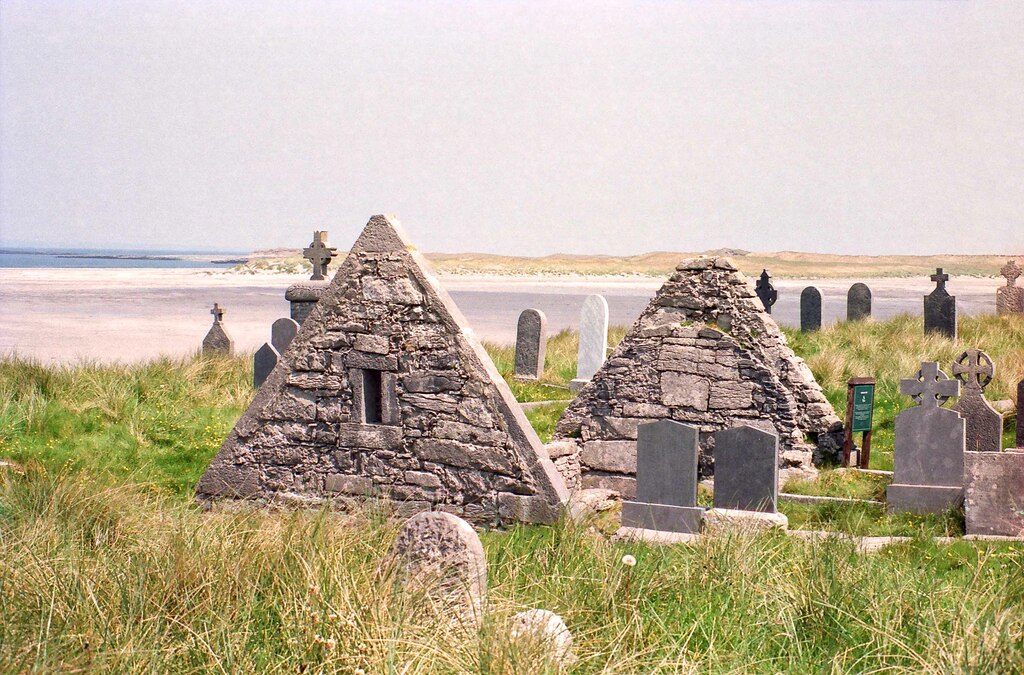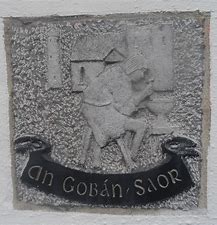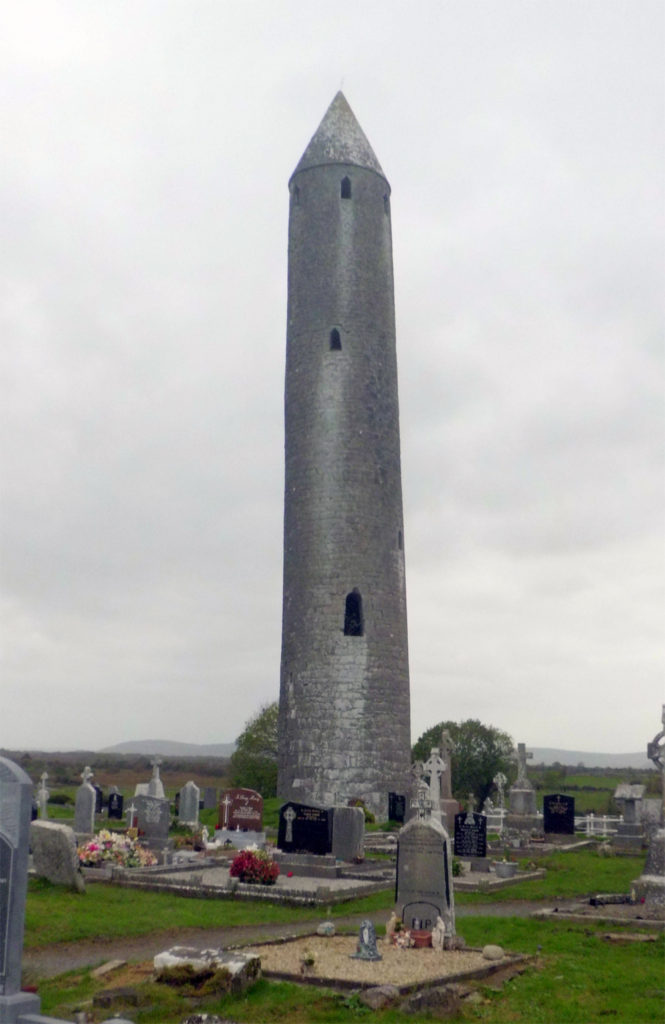St Colman mac Duagh
The Diocese of Kilfenora and the Diocese of Kilmacduagh were both erected and had their territories defined by the Synod of Kells in 1132. Kilmacduagh was based on the territory of the Hy Fiacrach Aidhne tribe, rulers of the area at that time.
In 1751 the two dioceses were united but because Kilfenora was in the ecclesiastical province of Cashel and Kilmacduagh in the province of Tuam, the Bishop of Kilmacduagh was made the Apostolic Administrator of Kilfenora, and it was decreed that the next person holding episcopal jurisdiction in Kilmacduagh-Kilfenora would be Bishop of Kilfenora and Apostolic Administrator of Kilmacduagh. This system of alternation continued down to the last bishop Fallon who resigned in 1866. After this date the dioceses were united with Galway.
Coleman Mac Duagh
The story of Kilmacduagh is much older and it takes its name from the extensive ruined monastic site situated near the present day town of Gort in south County Galway.
The name in Irish means the “church of the son of Duagh” and from the “Felire na Naomh na hEirinn”, Calendar of the Saints of Ireland (Martyrology of Donegal) written by the chroniclers led by Br Mícheál Uí Cléirigh, we know that Duagh was the father of St. Colman the founder of the monastic settlement.
Colman’s mother was called Righnach and there is a story about his birth that tells that the then King of Aidhne called Colman, father of Guaire (the hospitable) was informed in a prophecy that the pregnant Righnach’s child was destined to surpass all those in his illustrious lineage. The king became obsessively jealous and Righnach had to flee in fear of her life and that of her unborn child.
Unfortunately she was caught by some of the king’s men and they tied a heavy stone around her neck and threw her into the deepest part of the Kiltartan river. Miraculously she survived and the stone can still be seen on the river edge. Taking shelter a distance away, the child was born and she waited under an ash bush for help but only two clerical pilgrims came on the scene but one was lame and the other blind so were not able to procure water to baptise the infant. They prayed for divine intervention and suddenly a fountain of spring water gushed forth under the shelter of the tree. The clerics undertook to look after and educate the infant an offer Righnach willingly accepted under the circumstances. The well is still seen in the townland of Corker and bears St Colman’s name Tobar Colman to this day.
The Hermit
The early Christian church in Ireland took a very different form than that of the Roman church in the west and adopted many practices more associated with the eastern Christian congregations of Egypt and Syria which would later become the Coptic and Eastern Orthodox churches. One such practice was that of holy men and women seeking out solitude in remote places and living as hermits. This form of seeking privation to accentuate their spirituality became very popular in the early Irish church and the islands of the west coast of Ireland are dotted with early monastic settlements chosen for their remote and harsh conditions.

Colman MacDuagh was educated at St Enda’s monastery on Inishmore, the largest of the Aran Islands, where later he spent his early life in solitude there as a hermit, later living in caves at Keehillain the Burren area (modern day Co Clare).
King Colman, who had tried to kill Righnach, his mother, when pregnant with Colman, died and was succeeded by his son Loigneun who reigned for seven years. When he too died, his brother Guaire mac Colman succeeded him as ruler of the Hy Fiacrach Aidhne in A. D.604. King Guire invited his kinsman Colman Mac Duagh back from his life of solitude by granting him lands to build a church.

Legend relates that the site of the church was chosen by Colman when his girdle fell to the ground whilst he was walking and praying for guidance in choosing a site for his church. He took this as a sign from God to where he should have his church. Colman became Abbot bishop of the territory of the Hy Fiacrach Aidhne. The structure of the church would most likely have been constructed using wood from the surrounding forests. It is said that King Guaire sent labourers and teams of oxen to help in its building. St Colman’s girdle was preserved by the Uí Seachnasaigh, (O’Shaughnessy) clan up until the 17thCentury and over time it was studded with precious stones and ornamented. Unfortunately its whereabouts is unknown and it may have been destroyed in the wars of the 17thCentury. Legend had it that it could only be worn by a chaste person and no matter how thin a person was, if unchaste, they were unable to fit it on!! St Colman died in A.D. 632 and in the Martyrology of Donegal his feast day is assigned to the 2nd February. Common practice in the diocese of Kilmacduagh, from earliest times to the present day, considers the 29th of October to be his feast day. It is also interesting to note that he is also venerated in the Eastern Orthodox Church.
The monastic complex of buildings on the Kilmacduagh site date from different times and it is difficult to ascertain where exactly the ancient church of St Colman was situated. However, it is generally believed that it was located where the 12th Century cathedral building is sited.
Gobán Saer
 Popular legend suggests that Gobán Saer the famed 7th Century builder or stonemason( Gobán – Gabhan – Smith Saer- carpenter) was employed by King Guaire to build St Colman Church. Legend tells that Gobán Saer, an illiterate monk, was blessed by St Madoc or Aidan of Ferns and given the gifts to be able to build in either stone or in wood was employed throughout Ireland building churches.
Popular legend suggests that Gobán Saer the famed 7th Century builder or stonemason( Gobán – Gabhan – Smith Saer- carpenter) was employed by King Guaire to build St Colman Church. Legend tells that Gobán Saer, an illiterate monk, was blessed by St Madoc or Aidan of Ferns and given the gifts to be able to build in either stone or in wood was employed throughout Ireland building churches.
Little is known of the subsequent monastic history of the site though there is a reference in the Annals of the Four Masters that in the
‘Aois Criost,Ochtc céda ceathair décc,an dara bhliadhain ficht a dAobh,Aedh Oirdnide.Indreachtach Epscop Cille Mac Duach……’
‘The Age of Christ 814, twenty second year Aedh Oirdnidhe.(High King of Ireland) Innreachtach,Bishop of Kilmacduagh,……. died’
The round tower at Kilmacduagh is the tallest remaining intact tower 34 metres (113ft) tall though it is 1.05metres off vertical. The Irish name for these structures is Cloighteacha (Cloigthithe pl) meaning Bell towers and it was for this purpose they were originally constructed though they also would perform an additional purpose of a lookout tower in the years to follow.
Na Gall -The Foreigners
The first raid in Ireland by the Vikings or Norsemen was recorded in AD 795 with an attack on the monastery founded by St Columcille on ‘Rechrainn’ or Lambay Island near the modern city of Dublin. The Norsemen began by attacking island and coastal monasteries, plundering and robbing them of their sacred gold enshrined and jewelled books, chalices and relics, later they expanded their scope travelling inland along river routes such as the Shannon until only the most remote monastic sites were left untouched.
It is recorded that the Norsemen landed, possibly at Meadhraighe (Maree, near Oranmore) in 866 to attack the nearby Kilcolgan monastery and on this occasion travelled throughout the kingdom of Aidhne leaving no monastery untouched including that at Kilmacduagh.
Whilst initially returning to their bases on the Western Isles of Scotland and on the Isle of Man, the Vikings began establishing “Longphorts” in Ireland at strategic river junctions and coastal sites where they could over winter and process their booty of slaves and goods to their other settlements throughout Europe.
Although not unknown for the Irish to attack and burn rival kings’ monastic foundations, the severity and the usual accompanying murder of any monks found there, in turn led to a massive disruption in the performance and function of the Irish Celtic church. Many monastic settlements were abandoned and their monks retreated to more remote places for safety. There are some indications of the return of paganism amongst the masses of the population in areas of the country.
Gradually from the 10th Century onwards, the Norsemen raids became less frequent, as the raiders developed major settlements on the coast such as Limerick and on Inis Cathaigh (Scattery Island),entering trading arrangements with local chieftains, some even converting to Christianity. This coupled with the efforts of many Irish, Kings to combine and defeat the Northmen, confining them to their coastal settlements. Their settlement at Limerick was brought under the control of the DálCais of Tuath Mumhan (Thomond) This culminating in the defeat of the Dubhlinn (Dublin) Norsemen and their allies by Brian Borumha (Boru) at the of Clontarf in 1014.
![]()
